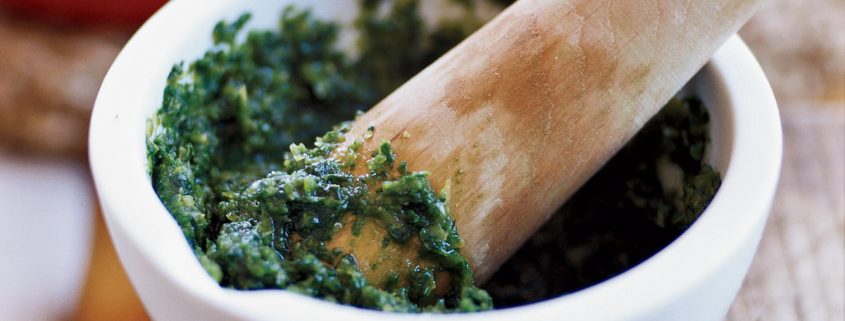But there is pesto and pistou! A little history is needed …
Pesto is a Genoese sauce traditionally composed of basil, garlic, cheese, pine nut and olive oil. It is the most consumed sauce in the world after tomato sauce.
The word “Pesto” comes from the Italian “pestare” meaning crush, squeeze, pound. “The Romans already used a mixture of oil, garlic and salt to flavor the fish.
The pesto as we know it today, would have entered the Provençal culinary heritage since the Middle Ages, when the city of Nice was then Genoese … Then the recipe would have won all Provence. In Genoese dialect the “o” is pronounced “ou” hence the name of “pesto” which by oral transmission was pronounced pesto, before becoming crossing the border, “pistou”, word (and recipe) adopted by the Provencal!
The pistou would therefore be the cousin of the pesto even if the two recipes differ today … But back to the Ligurian pesto and the traditional recipe …
According to legend, there is talk of a convent (San Basilio) on the heights of Genoa. A monk, tired of eating anchovies on a daily basis, decided to pick aromatic herbs including basil (name given in honor of the patron saint of the convent, in this case Basilio), and then added them to other ingredients. Once the recipe is finished, it is offered to the faithful and it will become the famous ‘Pesto alla Genovese’. Today, we use pistou in a wide variety of recipes: it decorates a tomato sauce, a tian and any summer vegetable.
We also make delicious biscuits appetizers … By extension, the Provencal often call the basil … pistou!
And it is not uncommon in the markets of Provence to hear people asking for ‘pistou’ while talking about the scented basil bouquet … they will slide into their basket. The pistou is the essential ingredient of the pistou soup, a soup of fresh and dry vegetables to which we add pasta. It can also be used as an accompaniment to pasta dishes. Unlike ligurian pesto, the pistou is prepared without pine nuts and the cheese is optional.



